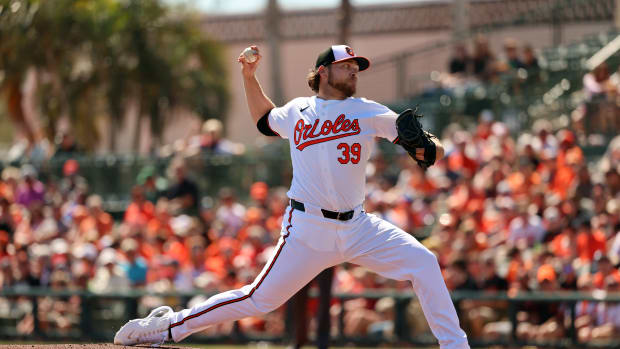
Explaining A.J. Burnett's turnaround
A.J. Burnett looks nothing like the pitcher he was with the Yankees the past two seasons. (Getty Images)
On Thursday, A.J. Burnett tossed 6 2/3 strong innings against the Phillies, and earned a win in his eighth consecutive start, the longest streak by a Pirate since Dock Ellis in 1974. After three increasingly frustrating years in the Bronx, the enigmatic righty has recovered the form that netted him a five-year, $82.5 million contract from the Yankees following the 2008 season in the first place. Speaking of first place, the Pirates aren't in it, but at 40-35, they're just one game behind the Reds in the NL Central race, and tied for the league's second Wild Card spot. Not too shabby for a pitcher who was rocked for ERAs above 5.00 in each of the past two seasons, or for a team that hasn't posted a winning record since 1992.
With the win, Burnett's record is now 9-2, accompanied by a 3.31 ERA. I don't talk about pitcher wins very much in this space because they're an overblown stat that has plenty to do with the levels of support a hurler receives from his offense, defense and bullpen on a given day, a measure of good timing rather than moral fiber. Nonetheless, Burnett's record is noteworthy because he's doing it with so little offensive support. The Pirates, whose offense is best described as "Andrew McCutchen and the Seven Dwarves," are scoring just 3.63 runs per game overall, the second-lowest rate in the National League, and when Burnett's on the mound, they're managing just 3.94. They're bashing out a comparatively robust 4.50 during this streak, but they've squeaked out wins of 1-0, 2-1, 3-2, 4-3, and 5-4 along the way. Furthermore, it's not as though Burnett has pitched badly in any of those games; he has allowed as many as three runs just twice in that span, including Thursday, and has delivered six quality starts out of eight. In fact, the only game in which Burnett has allowed more than three runs was a May 2 debacle in which he was pounded for 12 runs in 2 2/3 innings by the Cardinals. Remove that start from his line and his ERA would be 2.05.
Why is Burnett succeeding when he scuffled in New York? Some have attributed the turnaround to the relative lack of pressure pitching in Pittsburgh, or an adjustment in mindset. We shouldn't discount those factors, particularly when the gap between Burnett's stuff and his results was so wide during his last two years in pinstripes. Nobody likes to have boos raining down upon them as they try to do their job, particularly when they hit a snag. But neither should we go overboard in pointing to those intangible, unquantifiable factors. Even a well-written profile is bound to be somewhat reductionist in its portrayal.
Even so, the numbers tell a compelling story that in this instance is hardly at odds with such explanations. On the mound, Burnett has received plenty of support while avoiding the self-destructive tendencies that plagued the last two years of his stay with the Yankees. He walked 3.8 per nine in 2010-2011 but is down to 3.2. He allowed 1.3 homers per nine but is down to 0.8. He hit 0.7 batters per nine but is down to 0.2. He threw one wild pitch for every 9.1 innings but is down to one for every 27.2 innings. His Fielding Independent Pitching -- an estimate of his ERA based upon his strikeout, walk, hit-by-pitch and homer rates -- has dropped from 4.80 to 3.67. Burnett's actual ERA has dropped more drastically than that — from 5.20 in 2010-2011 to 3.31 — because his defensive support has improved considerably via a .278 batting average on balls in play, down from .310. That may reflect the fact that fielders are generally sharper when they're not watching pitchers struggle by walking everyone in the ballpark.
Furthermore, batters aren't hitting Burnett nearly so hard. In 2010 and '11, opponents hit .272/.352/.461 against him, with 39 percent of the hits going for extra bases, but they've hit .235/.302/.336 against him this year, with just 22 percent going for extra bases. He's doing a much better job of keeping the ball on the ground; his groundball rate in those two years was a respectable-but-not-exceptional 48.4 percent, but this year it's up to 57.6 percent, the sixth-best rate among ERA qualifiers.
Underlying all of those positive developments is an adjustment in repertoire. According to the PITCHf/x data at BrooksBaseball.net, Burnett threw his four-seam fastball 42 percent of the time last year, and his two-seamer (a/k/a sinker) 14 percent of the time, a ratio of 3-to-1. This year, he's at 36 percent four-seamers and 26 percent sinkers, a ratio of 1.4-to-1. The four-seamer generated groundballs on 31 percent of balls in play last year, and is up to 44 percent this year, while the sinker has been above 60 percent in both years. Groundballs tend to stay in the ballpark, hence their value.
Leaving the AL East hasn't hurt Burnett, either, though it's difficult to put too much stock in his drastic home/road ERA split — 1.11 versus 6.55 — given the size of the samples (33 innings in the latter case). But suffice it to say that the Pirates' PNC Park is less conducive to homers; according to The Bill James Handbook 2012, while Yankee Stadium increased home runs by 31 percent from 2009-2011, PNC reduced them by 13 percent. Meanwhile, according to Baseball Prospectus' Quality of Opposing Hitters data, Burnett's opposition was 11 percent more productive than the average hitter on a per-plate appearance basis once you adjust for ballpark and league (captured in a stat called RPA+), but is nine percent more productive than average this year. A slight drop, but a step in the right direction.



































